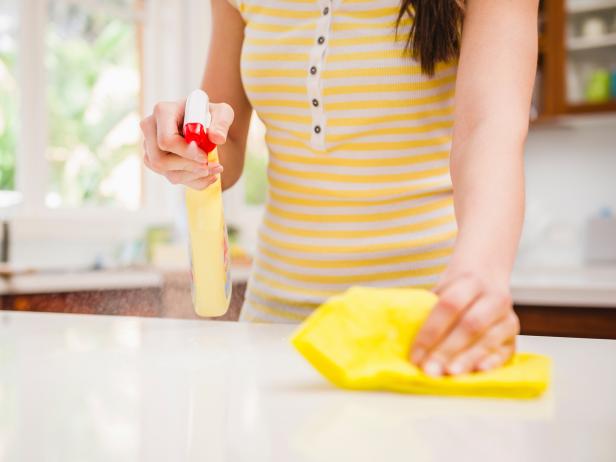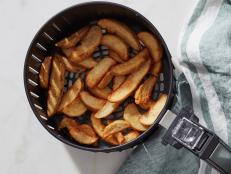How to Sanitize Your Kitchen In Two Easy Steps
Cleaning your kitchen is about more than wiping down your counters.

Jacobs Stock Photography Ltd/Getty Images
Keeping a clean kitchen is a good rule to live by, and it is important to sanitize your kitchen properly after every use. The United States Department of Agriculture (USDA) has a two-step method, which is commonly used in restaurants and other food service operations. You can also use this method in your own home.
What You're Doing Wrong
After you’ve cooked a meal for your family, washed your dishes, and wiped down the counters, it’s time to relax, right? Actually, while you’ve done most of the work to clean up your kitchen, it's is not fully sanitized.
Wiping your counters down with a wet paper towel or a sponge doesn’t destroy harmful microorganisms. If you scrambled eggs for omelets on the counter that morning, you may have salmonella lurking on your counters until dinnertime. In order to avoid the spread of microorganisms the USDA recommends a two-step process involving cleaning first and then sanitizing.
Cleaning is the act of removing any visible dirt. When you eat a peanut butter and jelly sandwich on a plate, cleaning the plate is getting rid of any crumbs and peanut butter or jelly that dripped onto the plate. It can also remove the bacteria from the plate to the sink. Sanitizing, on the other hand, is how you decrease microorganisms on a surface to safe levels. Microorganisms include bacteria that you cannot see. Once you moved that bacteria from your plate to the sink, you still need to destroy it so it won’t make you sick.
Sanitizing is not sterilizing. Sterilizing means that 100% of microorganisms are destroyed, which is done in doctors' offices or hospitals, not in your kitchen or in restaurants.
Follow the two-step guidelines to clean and sanitize your kitchen, and it can help minimize your risk of foodborne illness.
How to Do the USDA Two-Step Process
Step 1: Clean
You want to do these steps in the order recommended. Cleaning removes visible dirt and bacteria that cause you to become ill. Wash countertops, other surfaces and your kitchen sink using warm, soapy water, then wipe them clean with a single-use paper towel. If you choose to use a kitchen towel, make sure it is a clean towel. (Wash your kitchen towels frequently in the hot cycle of your washing machine.)
Cleaning makes sure that bacteria is removed from surfaces. Pathogenic bacteria can live on surfaces for a long time. For example, salmonella (which can be found in raw poultry or shelled eggs) can live for up to 32 hours. Cleaning with warm, soapy water can remove dirt, grime, and some bacteria from a surface, but it will not destroy or kill the bacteria.
Step 2: Sanitize
After you clean, the next step is sanitizing in order to destroy bacteria. Sanitizing is most effective after you have cleaned the surface — that is why it is important to follow these two steps in the correct order.
There are a variety of sanitizers you can use at home. You can make your own homemade version by mixing a solution of 1 tablespoon of liquid chlorine bleach per gallon of water. You can also use commercial sanitizers or sanitizing wipes.
The proper way to sanitize is to pour or spray the sanitizing solution on surfaces and wipe clean with a paper towel. Make sure that the surfaces are completely dry before using them again – this includes your sink. If you’re using a store-bought commercial sanitizer, then follow the manufacturer’s directions listed on the label. Some commercial sanitizers require the surfaces to be rinsed after using, so read the label carefully.
What About Using a Dishwasher?
Your dishwasher is effective in cleaning and sanitizing utensils, plates and cutting boards made with dishwasher-safe non-porous materials (like acrylic, plastics or glass), which is a great reason to rely on it for washing your dishes. If you don't have a dishwasher, at the very least it's important to sanitize dishes and utensils that may have come into contact with raw meat, or if someone in your household is sick.
To sanitize dishes and utensils, use soapy water to wash them and then use your homemade sanitizing solution described above. For utensils, soak them in your sanitizing solutions, while you can pour some sanitizing solution on cutting boards. Let the dishes or cutting board stand for a few minutes in the sanitizing solution before rinsing it off with water. Lastly, air dry your dishes or wipe them dry with a single-use paper towel.
Toby Amidor, MS, RD, CDN, is a registered dietitian and consultant who specializes in food safety and culinary nutrition. She is the author of The Greek Yogurt Kitchen: More Than 130 Delicious, Healthy Recipes for Every Meal of the Day.
*This article was written and/or reviewed by an independent registered dietitian nutritionist.
Related Content:

































